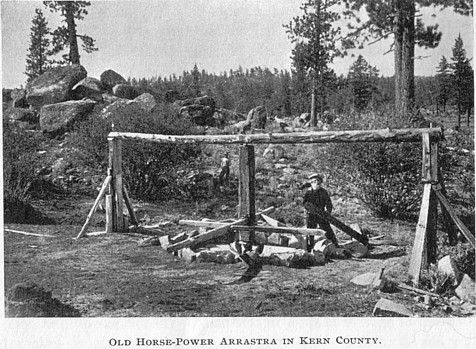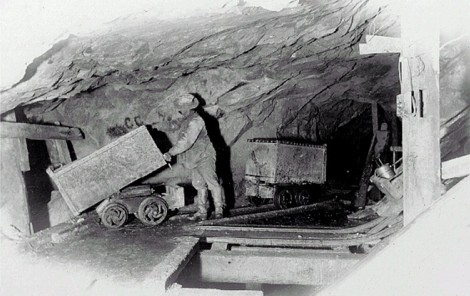THE FOLLOWING INFO IS
PRESENTED FOR ITS HISTORIC VALUE. PROCESSING WITH MERCURY IS NOT
RECOMMENDED.
Amalgamation in cyanide solution presents no difficulties within the
requirements made on it a close saving on the plates not being essential.
The loss of mercury is high as it is dissolved to be precipitated in the ore
and in the zinc box. Most
silver ores
and some
gold ores
contain base elements which unite with and destroy cyanide to an undesirable
extent. The mercury unites with or replaces some of these elements, in the
latter case forming a compound of mercury and cyanide which is an active
solvent of gold and silver. When the solution is again brought in contact
with the ore, the precious metals are dissolved and replace the mercury
which is precipitated in the ore. The mercury thus plays an important and
beneficial part, but only a small amount of mercury is utilized in this way,
the greater part being precipitated in the zinc box. This deposition on the
zinc, if not too excessive, appears to assist the precipitation of the
gold
and silver, due to the formation of a galvanic couple. The mercury cannot be
recovered economically under ordinary conditions. The strength of the
solution should be kept down to one-half pound of potassium cyanide per ton
of solution to prevent the too rapid dissolution of the plates and mercury,
though a solution of two-pound strength has been successfully used. As the
life of the plates is limited to from six to nine months and the
amalgamation
rather roughly carried on, silver plating the plates is an inadvisable
expense. No aids or methods of prolonging the life of these plates have yet
come into use, notwithstanding that the item for renewals is an important
one. The lower plate and lower part of each plate is eaten through first.
As the amalgam is cleaned up the closest from these places, it gives weight to the natural conclusion that a thick coating of hard amalgam would prolong the life of the plates. The cyanide keeps the plates beautifully free from stains as it dissolves the copper compounds as fast as formed, and owing to its low strength does not harden the plates to the extent that might be expected. The plate tables should be built water tight that neither the mercury nor solution may run through, for the plates are eaten through irregularly and it may not be convenient to remove them when the first spot appears. In fact it is the custom to repair the first spots or bare places by tacking pieces of old plates over them.
Iron tables or those having the bed of plate-iron or steel and water tight would be excellent. Raw copper plates of extra thickness with backs covered with a thoroughly solution-proof paint, in two-foot sections with a drop between each, the sections to be easily and independently removable or changeable, are the lines along which these tables should be designed. The plates should not be allowed to project beyond their backing as the ends are gradually dissolved down to dangerous knife edges. The solution being weak does not injure the hands of the workmen, though it may make them rough at times. Rubber gloves are not required. In designing and building a mill for crushing in cyanide solution, every effort should be taken to prevent the leaking and spilling of the gold-bearing solution, while the floors should be arranged to catch and carry any such solution to a sump tank. The loss from this source is high in some gold mills.
Blanket Tables:
These are troughs about 10 or 15 feet long, 15 or 16 inches broad,
inclined at about 10 or 15 and covered with coarse blanket. They are
extensively used at quartz
stamp mills in Australia and California for catching the gold
as it flows from the batteries. Several troughs are used side by side, so
that while the blankets of one are being washed, the
gold sand may be flowing over the others. If there is a
series of troughs extending longitudinally 20 or 60 feet in length, the
upper blankets may be washed every hour, while the lower ones may only
require to be washed once a day. The upper blankets may contain 70 or 75 per
cent of the gold. The gold obtained is mixed with iron
pyrite and other material and it is therefore further washed
by hand in pans. Blanket stuff may also be concentrated on tables or be
directly amalgamated.
Pan Amalgamators:
In Pan amalgamators,
amalgamation and grinding may be carried on simultaneously. This
however, is not usual. The charge is wet, definite in quantity and worked
upon for a specified period. The ordinary pan amalgamator consists of a
circular iron pan rising from the center of which there is a hollow cone.
The bottom of the pan is lined with a disc or dies of white cast iron. The
sides may be of wood. Passing up the hollow cone enveloping the pan cone,
the revolving grinding surface or muller which is faced with shoes. Usually
the muller can be raised from the bottom of the pan by screwing up on a
central shaft, or the shaft itself can be lifted by gearing beneath the
pan. In this way the grinding power of the muller can be regulated.
About 600 to 800 lbs. of stuff are treated at a time. Coarse sand which is mixed with water to form a pulp, takes to grind .and amalgamate about 4 hours, finer material 2 hours. About 5 H. P. is required per pan. By rapid motion of the mullers (65 to 85 or even 100 revolutions per minute) the pulp is thrown outwards. At the periphery of the pan it comes in contact with properly placed curved plates, which guide it back towards the center of the pan. To assist amalgamation the pulp may be kept hot by a jet of steam or by a steam jacket on the bottom of the pan. In Rae’s patent electric system of amalgamation, a current of electricity is passed through the pulp, with the result, it is said, of preventing the fouling and consequent loss of quicksilver. Several electrical arrangements which are said to improve and accelerate amalgamation, have been used in connection with stamp work and pan amalgamation. Each pan requires 10 to 100 lbs. quicksilver. One hundred pounds of mercury dissolve 0.5 to 1.75 oz. of gold. Among pans with plane circular grinding surfaces, we have the Knox, the Varney and the Wheeler pans. The pans with conical mullers may have the bottom of the pan inclining downwards towards the center as in the Hepburn and Petersons pan, or as in the Belden pan inclining upwards towards the center. In the former pan the pulp tends to flow inwards without the assistance of guide plates. In the Excelsior and other pans the form of the base of the pan and mullers is conical. The Combination Pan may be taken as a standard form. In the Hinkle and Capp amalgamator and grinder, perpendicular mullers are pressed laterally by centrifugal force against the perpendicular sides of the pan.
From grinding pans the pulp passes to settlers where it is thinned by the addition of water, and the quicksilver and amalgam, which has become finely divided, is allowed to settle. A ten stamp silver mill requires about six pans and three settlers. A standard pan holds from one to two tons of pulp. A 5 foot pan weighs 6,500 lbs.
The Bennett Amalgamator. This is used for placer works. The ground is scooped up by a dredger and passed into a trammel revolving partly under water. Here the stones are separated from pay dirt which falls into a water tank where jets of water cause it to pass over amalgamated plates. It requires 150,000 gals, of water per 1,000 cubic feet of earth. It is said to work placer ground for 1 to 3 cents per cubic yard, the usual price being 3 to 9 cents.
Continue on to:
Cleaning Amalgam and Clean-Up Procedures
Return To:
Hard Rock Quartz Mining and Milling


